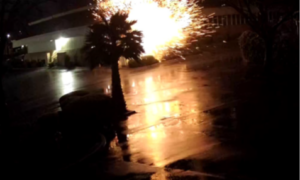On July 24, a man was seen pushing a flaming car into a gully near Alligator Hole in Bidwell Park in Chico, California, starting the fourth-biggest fire in state history, the Park fire, which has consumed more than 620 square miles in Northern California.
The suspect, Ronnie Dean Stout II, 42, of Chico, was arrested last week by Cal Fire arson investigators on suspicion of starting the devastating fire and fleeing shortly after, according to a statement from the Butte County District Attorney’s Office.
Stout was arraigned this week in Butte County Superior Court and charged with both intentional and reckless arson.
He told authorities that his vehicle caught fire by accident after he pulled it off the road and ended up in a grassy area, where he revved the engine.
The Park fire has become the state’s largest arson-induced blaze, per Cal Fire.
Stout’s alleged arson is one data point in a sobering statistic: 95 percent of wildfires in California are manmade, according to Cal Fire.
Agency spokesman Brent Pascua told The Epoch Times that just 5 percent of state fires are non-human related. And while most of California’s fires are caused by human events, arson fires are much less frequent than people may think.
In 2024, 38 arson suspects have been arrested so far in California, according to Cal Fire’s statistics. The agency also reported that arson fires have burned 2,583 acres, or about 4 square miles, in 2024.
Arson fire damage peaked in 2020 when nearly 70 square miles in California were destroyed, and in fiscal year 2022–23, arson civil cost recovery topped $80 million, more than double the total of the previous year, according to Cal Fire.
But even though 580 arson suspects were arrested from 2020 to 2023, just 0.9 percent of California’s wildfires in that time were caused by arson.
Most were accidental.
“With so many humans, it’s going to happen,” Pascua said.
Even in outdoor emergencies, starting a fire is not recommended, he said. Hikers or campers should instead focus on preparing with appropriate gear and avoid using fire, especially during hot, windy days, he advised.
An Accidental Trend
California’s persistent drought conditions have created a tinderbox of ignition fuel for fires, and although some wildfires have been started by lightning, many more are caused by accidents such as electrical problems or downed power lines.
According to Cal Fire, eight of the top 20 largest wildfires in California history were caused by lightning strikes—the other 12 were caused by arson, power lines, or other “human-related” issues. Some are still under investigation.
The November 2018 Camp fire in Northern California’s Butte County, for example, destroyed more than 18,000 structures and consumed nearly 240 square miles. The fire was sparked by downed power lines, according to Cal Fire.
In 2021, the Dixie fire destroyed more than 1,500 square miles across four Northern California counties—Butte, Plumas, Lassen, and Tehama—and was determined by officials to have been sparked by power lines.
The damages incurred by the fire prompted a coalition of timber companies, spearheaded by Oregon-based Collins Pine Co. and six other affiliated businesses, to bring a lawsuit against California-based Pacific Gas and Electric, alleging that the company failed to inspect, repair, and maintain its electrical equipment.
At the lower end of the range, in late July in Riverside County—about an hour east of Los Angeles—about 1 square mile went up in flames in a short-lived but damaging wildfire that officials say was sparked by illegal fireworks.
In a 2022 Nature Communications study funded partly by the University of California and UC–Irvine, experts also determined that human-caused fires in California were much more damaging than lightning-caused fires in the first several days after ignition.
“Human fires are on average 6.5 times larger at the end of the first day compared to lighting caused fires,” the study reads.
Staying Safe
The destructive nature of human-caused fires has prompted agencies such as Cal Fire to urge Californians to exercise common sense in areas where fire can easily start.
“In the springtime, the most common [cause of fire] that we see are people mowing their weeds down,” said Gary Couch, public information officer for Cal Fire and Fresno County Fire.
He said lawnmowers can send sparks that light dry grass on fire–but so can other types of equipment with hot exhaust or running gear.
Couch acknowledged how quickly lightning storms could start a fire but noted that “people that are still trying to create a defensible space” can create another fire when they are using equipment to mow grass or trim bushes.
He advised that Californians keep a bucket of water and a shovel on hand in case of fire when they’re working outside near any combustible material. He also said it was best for residents to do yard work between 6 a.m. and 10 a.m., when the temperature is lower and the humidity higher than in the afternoon.
Most importantly, Couch urged people to call 911 in the event of an accidental fire.














